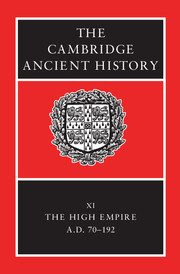Book contents
- Frontmatter
- PART I NARRATIVE
- PART II GOVERNMENT AND CIVIL ADMINISTRATION
- PART III THE EMPIRE
- PART IV ROME, ITALY AND THE PROVINCES
- 12 Rome and Italy
- 13 Spain
- 14 Gaul
- 15 Roman Germany
- 16 Africa
- 17 Cyrenaica
- 18 Britain
- 19 The Danube provinces
- 20 Greece and Asia Minor
- 21 Syria and Arabia
- 22 Judaea
- PART Va ECONOMY AND SOCIETY
- PART Vb ART AND CULTURE
- Chronological Table
- BIBLIOGRAPHY
- Index
- 1 The Roman world in the time of Marcus Aurelius
- 7 The Danube provinces
- References
18 - Britain
from PART IV - ROME, ITALY AND THE PROVINCES
Published online by Cambridge University Press: 28 March 2008
- Frontmatter
- PART I NARRATIVE
- PART II GOVERNMENT AND CIVIL ADMINISTRATION
- PART III THE EMPIRE
- PART IV ROME, ITALY AND THE PROVINCES
- 12 Rome and Italy
- 13 Spain
- 14 Gaul
- 15 Roman Germany
- 16 Africa
- 17 Cyrenaica
- 18 Britain
- 19 The Danube provinces
- 20 Greece and Asia Minor
- 21 Syria and Arabia
- 22 Judaea
- PART Va ECONOMY AND SOCIETY
- PART Vb ART AND CULTURE
- Chronological Table
- BIBLIOGRAPHY
- Index
- 1 The Roman world in the time of Marcus Aurelius
- 7 The Danube provinces
- References
Summary
Almost the entire period between the accessions of Vespasian and Septimius Severus was dominated by military affairs in Britain. Even during those relatively short periods when little or no campaigning is recorded as having taken place it can be argued that developments elsewhere in the civil zone of the province were conditioned by events on the frontier. Recently, greater emphasis has been placed on the achievements of the native aristocracy where the development and pace of romanization is seen to reflect more the latter's attitudes and aspirations towards Rome rather than the results of policies imposed by the invader. However, it is difficult to isolate civil developments from a framework imposed by the progress of conquest and its associated administrative structure.
Our written sources are dominated by Tacitus and, in particular, by the biography of his father-in-law, the Agricola, which also includes a commentary on political developments in Britain before the latter became governor. The Histories also offer some useful insights into the Civil War of 68–9 and relations with the Brigantian client kingdom during that period and at the start of the 70s. Second-century historical sources are much more limited, but nevertheless, and in conjunction with a rich epigraphic record, offer a framework for the principal developments on the northern frontier: the construction of Hadrian's Wall and the Antonine Wall. Although the recently discovered series of documents from Vindolanda offer vivid insights into military organization and military life in the north at the very beginning of the second century, they do not add materially to the historical narrative.
- Type
- Chapter
- Information
- The Cambridge Ancient History , pp. 559 - 576Publisher: Cambridge University PressPrint publication year: 2000
References
- 3
- Cited by

